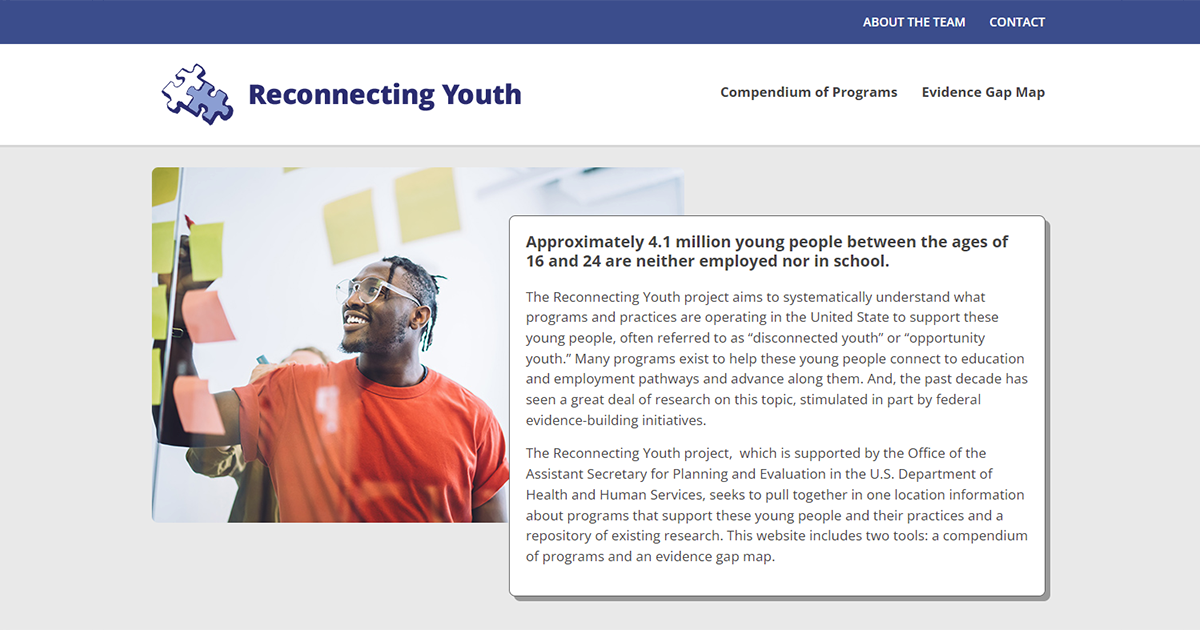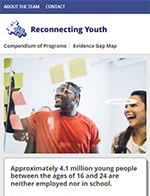Responding to Young People
An Analysis of Programs Serving Young People Not Connected to School or Work

 Sponsored by the Office of the Assistant Secretary for Planning and Evaluation (ASPE) at the U.S. Department of Health and Human Services, the Reconnecting Youth project aims to systematically understand what programs and practices are available in the United States to support young people who experience disconnection from school and work during the transition period to adulthood (typically defined as ages 16 to 24). It focuses specifically on services to help them reconnect to education, obtain employment, and advance in the labor market. This population of young people is often referred to as “disconnected youth” or “opportunity youth.” This project has produced two online tools to support these goals. The first is a compendium of programs, the focus of this publication, which provides an overview of 78 programs and the practices they employ. The second is an evidence gap map that looks at the available evidence about these practices to identify what evidence exists and where there are opportunities to build evidence.
Sponsored by the Office of the Assistant Secretary for Planning and Evaluation (ASPE) at the U.S. Department of Health and Human Services, the Reconnecting Youth project aims to systematically understand what programs and practices are available in the United States to support young people who experience disconnection from school and work during the transition period to adulthood (typically defined as ages 16 to 24). It focuses specifically on services to help them reconnect to education, obtain employment, and advance in the labor market. This population of young people is often referred to as “disconnected youth” or “opportunity youth.” This project has produced two online tools to support these goals. The first is a compendium of programs, the focus of this publication, which provides an overview of 78 programs and the practices they employ. The second is an evidence gap map that looks at the available evidence about these practices to identify what evidence exists and where there are opportunities to build evidence.
The study team from MDRC and Child Trends conducted an expansive search to identify programs that met the scope of the compendium and fielded a qualitative questionnaire to all programs from the search. The 78 programs in the compendium together were projected to serve nearly 100,000 young people in 2021. This overview provides high-level findings from the questionnaire and connects these results to findings from the evidence gap map. While not meant to be a comprehensive survey of all programs operating, the findings offer insights into what services and implementation practices are more common or less common, the use of innovative practices, and the breadth of activities programs undertake in support of young people.
Key Findings
- Program characteristics: Programs in the compendium reflect diverse geographies, years of experience, and annual number of participants served. The programs are mostly nonprofits operated by community-based organizations and most received public funding, indicating that they have established infrastructure to apply for and qualify for such grants.
- Population served: Most reported serving primarily young people. Programs were long in duration and intensity, indicating a high intended dosage of services throughout an extended engagement.
- Outcomes targeted: The majority of programs reported targeting both education and employment outcomes, indicating that they focus on a range of outcomes rather than specializing in one area. For education, they focus mostly on basic skills gains, high school completion, or postsecondary enrollment. For employment, they target mostly shorter-term outcomes (e.g., placement and readiness) rather than longer term outcomes (e.g., retention and earnings).
- Education and employment services: Most programs provided both secondary and postsecondary education services, indicating that programs may have a main service but meet young people where they are at and provide the education services they need. Most programs reported having both work readiness services to prepare young people for the labor market and job placement supports to give young people skills to gain a foothold in the labor market and access to quality jobs.
- Program implementation practices: A high percentage of programs provide support services, suggesting that programs provide comprehensive supports for young people to help them overcome barriers to entering education or employment. All programs reported employing at least one youth development practice in their delivery of services. Programs also often employed practices required of WIOA funding, as well as community partnerships or collaboration. Almost all programs used at least one racial equity practice, such as having a racial equity framework and representation of participant demographics in program leadership and staff.
- Data and evaluation: Nearly all programs reported collecting data about participation, employment outcomes, and education outcomes, but a minority had been part of a formal study or evaluation.
Conclusion
The questionnaire found that programs seek to serve the diverse group of young people who are disconnected from school and work by providing a wide range of services to support the diverse needs of the young people who come through their doors. Of course, a program alone cannot address the issues that lead to disconnection or mitigate all disparities in society. Systemic challenges exist beyond the reach of programs, including structural barriers and discrimination in the education system and labor market and social determinants of health. However, the wide scope of these programs indicates that they attempt to be as comprehensive as possible.
Many of the practices identified as essential to working with these young people by experts interviewed for this project were common. These include youth development approaches that focus on positive adult-youth relationships, career pathways approaches, and providing comprehensive supports. The questionnaire found that the programs largely employ these practices and approaches, indicating that program staff and experts in the field are largely in agreement about which practices best serve this population.
The Reconnecting Youth project’s companion to this compendium, the evidence gap map, surveys the extent of research available about the practices used by the programs in the compendium. Comparing its findings with the compendium reveals directions for future research.
- Some of the practices that were common in the compendium have a large body of research behind them. These include such practices as preparation or instruction for high school equivalency, work readiness training, and supports for basic needs. Practitioners, policymakers, and researchers can use this information to learn how best to build strong programs for young people.
- However, other common practices in the compendium have limited evidence with this population, suggesting priority areas for further research. These include such practices as employer engagement and career pathways approaches.
- Some innovative practices were not common in the compendium or the evidence gap map but have been found to be effective serving other populations and may benefit opportunity youth. These practices include two-generation models, entrepreneurship training, and dual enrollment. The same can be said of expanding service providers to include more community colleges and employers, which were not common practices in the compendium.
- More longitudinal research can help understand how to support young people who are reconnecting as they advance along education and career pathways. Currently, most youth-serving programs target relatively short-term outcomes.







